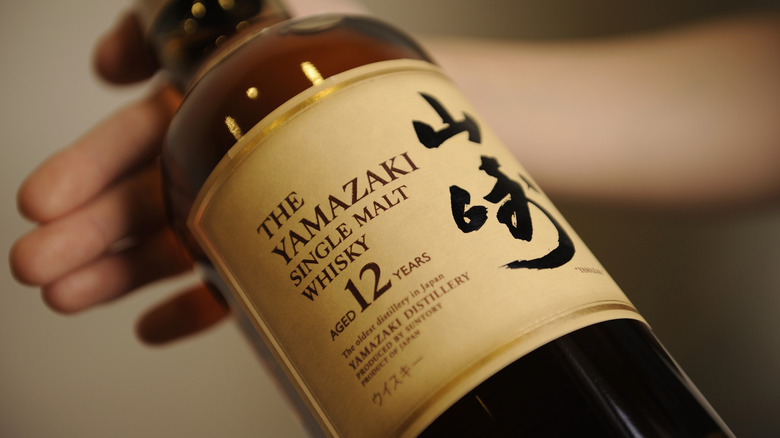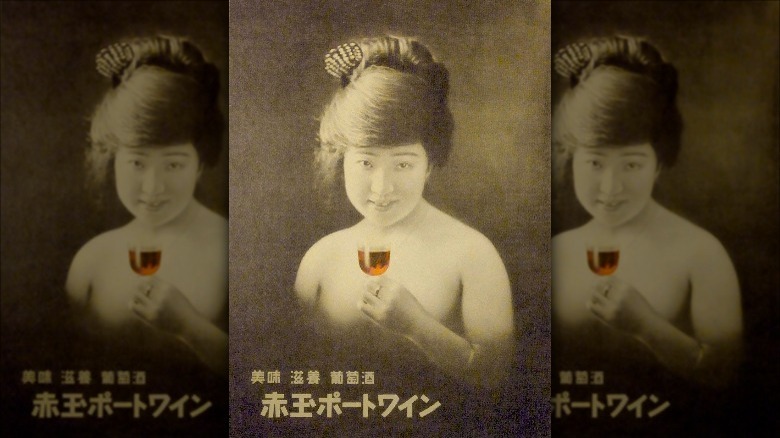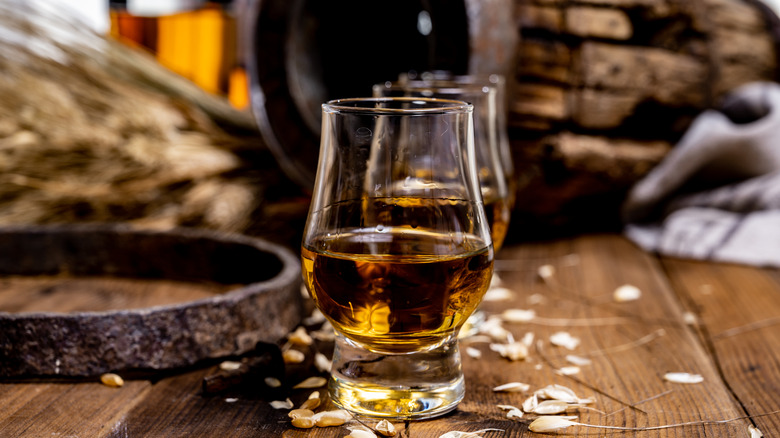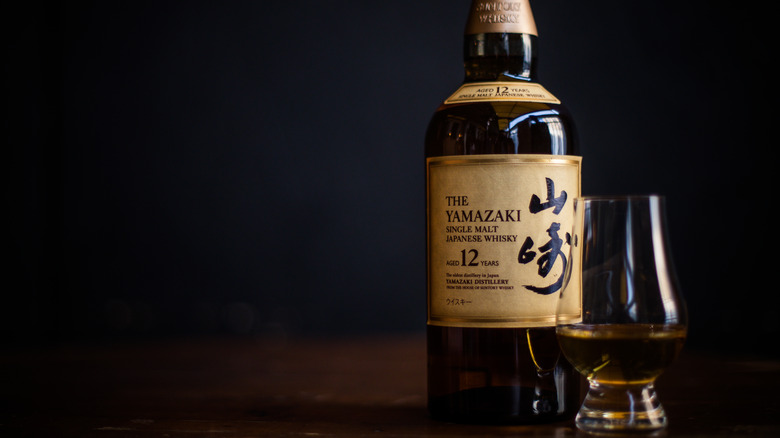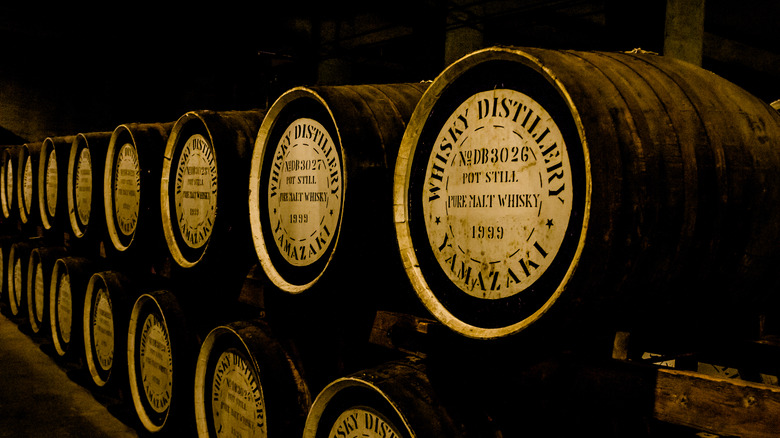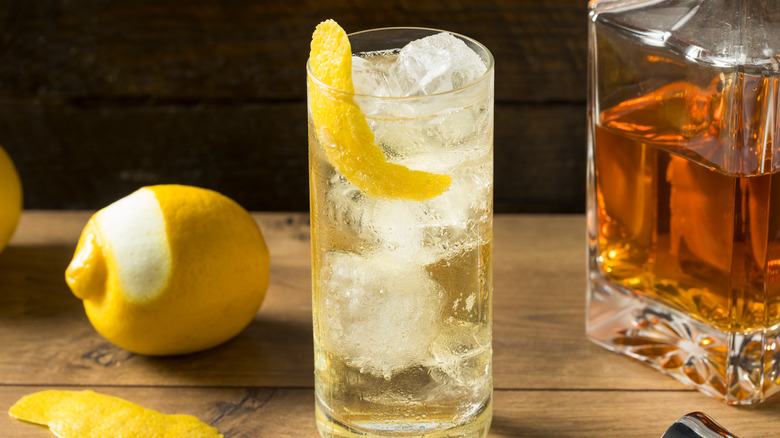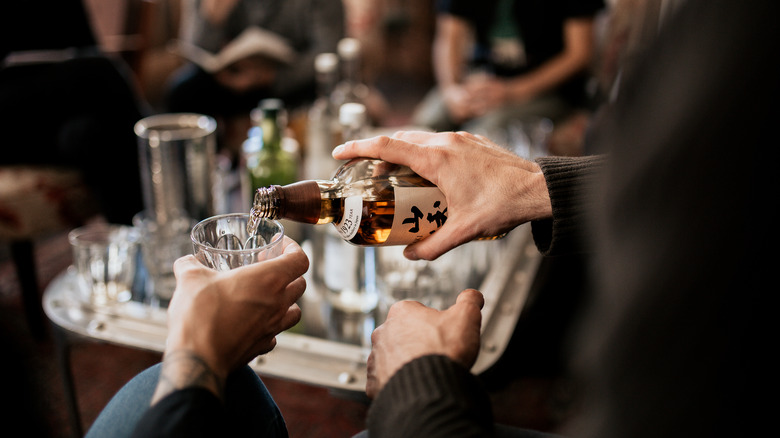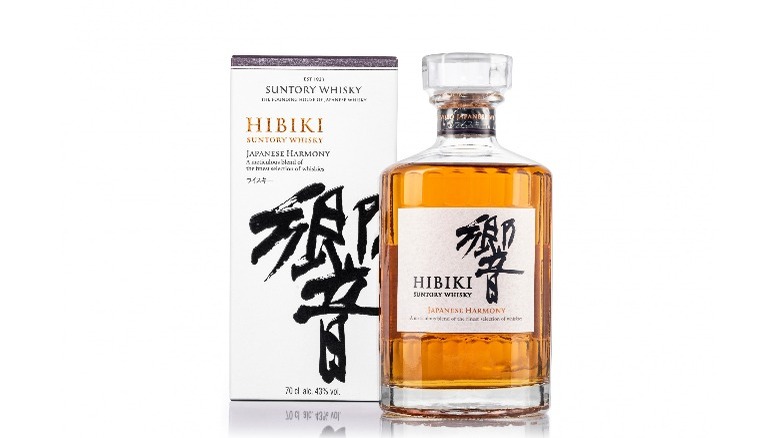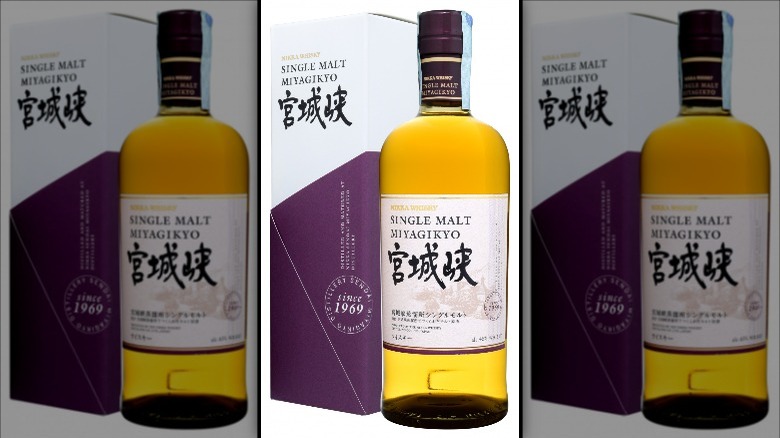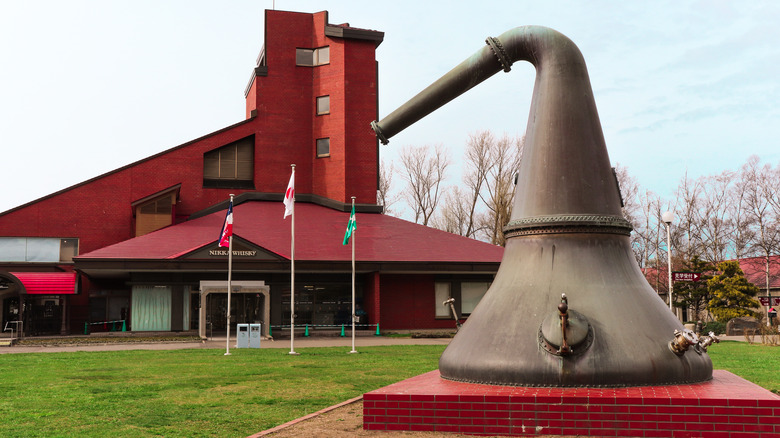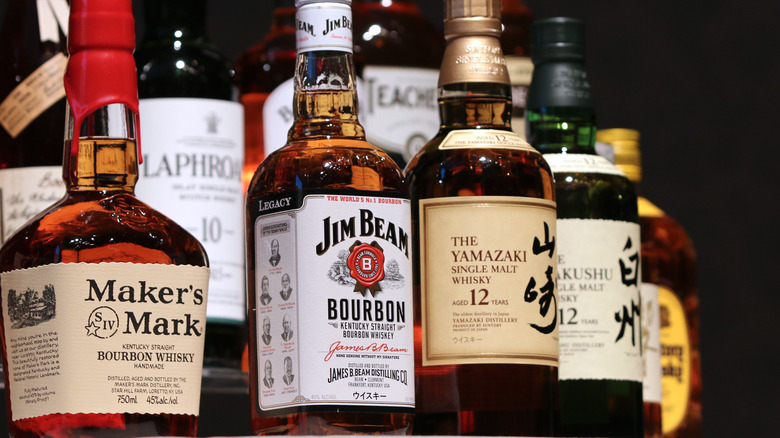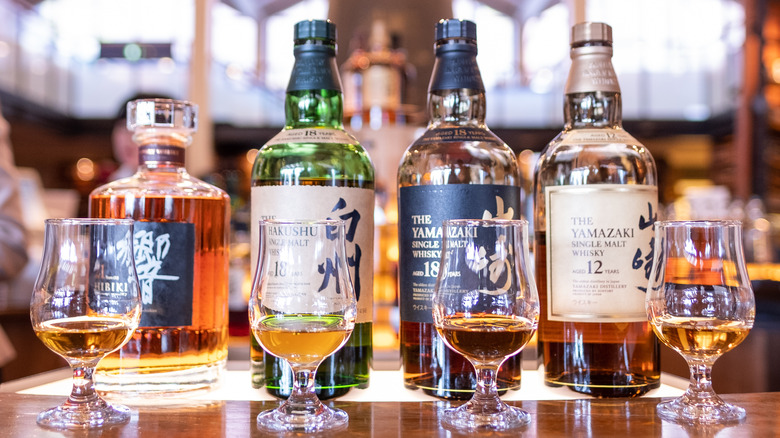Yamazaki 12 Year Whisky: Everything You Need To Know
When people think "Japanese whisky," Suntory inevitably comes to mind. Suntory is one of two top whisky brands in Japan and produces one of the finest single-malt whiskies to come out of the country. The youngest member of the Yamazaki line, made in the oldest distillery in Japan, the Yamazaki 12 Year Whisky does not suffer due to its relative youth. Instead, it transcends expectations and pioneered a whisky empire as Suntory's flagship single malt whisky.
Suntory uses malted barley to create their Yamazaki 12 Year Whisky. As a single malt whisky, all of the whisky comes from one distillery. While the name may imply that all whisky comes from a single barrel or batch, that is not the case. Single malt refers only to where the malt originates. To produce a wide range of flavors, the Yamazaki distillery employs a number of tactics. First, the company uses different styles of copper pot stills to create complex, varied flavors. They then age the whisky in more than five types of barrels, including bourbon barrels, hogshead barrels (which are basically Frankensteined barrels with new and old pieces), and some of their own barrels. These barrels are made with different woods and char levels, imparting different flavors to the whisky as it ages. Finally, Yamazaki blends the whisky of at least 12-year-old barrels together to create their 86 proof bottles.
It all started with wine
Japanese whisky has made a splash, with Yamazaki's Single Malt Whisky beating out longtime whisky champion Scotland for offering some of the best whisky in the world (via The Washington Post). That particular bottle was a specialty one aged in a sherry cask. Given all this, it might be surprising to some that Suntory started by making wine, not whisky.
Shinjiro Torii founded the Torii Shoten store in 1899, which specialized in making and selling wines. In 1907, it launched the Akadama Port Wine to smashing success. Torii wanted more, though. He dreamed of bringing Japanese distilled products to the masses. He built Japan's first distillery, the Yamazaki distillery, and premiered Japan's first whisky, Suntory Shirofuda. It was a flop. Undeterred, Torii created a new whisky: Suntory Kakubin. This time the product was a success, going on to become the No. 1 selling whisky in Japan.
Suntory kept innovating and working to bring unique products that showcased what Japan could do. Finally, in 1984, the first Yamazaki Suntory Single Malt Whisky bottles were released, and the rest is history. Today Yamazaki is still the top single malt whisky in Japan.
Scotch influence
When people think single malt, they typically think scotch. While it is commonly ascribed to the drink, the name can be used outside of Scottish whisky. It is no mistake, though, that much of the language used around Japanese whisky resembles that of scotch. Suntory's website even states that they took their inspiration from scotch whisky. Japanese whisky was and continues to be directly reflective of traditional scotch-making practices while still being entirely its own creation.
Yamazaki 12 Year Whisky uses malted barley grain as the base, the same as scotch. The barley and stills used in Japanese whisky are commonly imported directly from Scotland (via Difford's Guide). The reasons for these similarities come from the fact that Japan's first distiller, Masataka Taketsuru, spent time in Scotland learning the traditional scotch-making process, a process that he brought home to Japan and used as the basis to create Japanese whisky at the Suntory Yamazaki Distillery.
What does it taste like?
The similarities and influences are not to say that Japanese whisky is just a copy of scotch. Far from it. Japanese whisky, especially Yamazaki, has its own unique flavor and process. While Japanese whisky uses many techniques inspired by scotch, it has its own twist. As Difford's Guide notes, the Japanese oak casks used in the aging of some of the barrels give the whisky a unique flavor of sweet incense and citrus.
Additionally, the climate of Japan is far different from the climate of Scotland. It tends to be warmer, which facilitates greater wood flavor extraction. This climate difference means that even with similar distilling processes, the resulting beverage will have a flavor and character of its own.
The flavor of Yamazaki 12 Year Whisky is complex. The company describes the nose as being full of rich fruits, such as pineapple, grapefruit, and candied orange, as well as subtle spices like cinnamon and Japanese oak. The tropical flavors continue with a coconut, cranberry, and butter palate. The finish is long with spicy notes of ginger and cinnamon.
How is Yamazaki 12 Year made?
All whisky starts, at its core, with water. As Suntory's website notes, the Yamazaki Distillery is located at the foot of a mountain in southwest Kyoto. Shinjiro Torii took great care in choosing the site for the distillery and ultimately settled on this location due to its source of mineral water. The location is also relatively hot and humid, which the company considers ideal for whisky making.
The raw barley is malted, turned into mash, fermented, and then distilled using copper distillation pots, some of which were imported from Scotland. Finally, the whisky is left to age in barrels for at least 12 years. After this, skilled blenders work with barrels of whisky, all of which were produced at the Yamazaki distillery, to balance all the flavors and create its iconic whisky. The process is time-consuming and takes over a decade from grain to finished product.
How to drink Yamazaki 12 Year Whisky
Since Suntory basically premiered the whisky business in Japan, it had to teach the public how to drink its offerings, so they created Torys bars across the country. Here they revolutionized the drinking culture by introducing drinks such as the highball (a drink of whisky, carbonated water, and ice), as well as the Mizuwari, a simple combination of water and whisky meant to be drunk with a meal.
These are still popular ways to drink whisky in Japan — so much so that the company actually produces its own canned highball and soda water. Let's remember, though, that these drinks were popularized when Yamazaki was producing non-age statement whiskies. While you are certainly welcome to mix a glass of Yamazaki 12 Year with some water or soda, a better way to experience this whisky would be either on the rocks or straight up. This will allow the flavor to show through undiluted.
Why is it so expensive?
Japanese whisky as a whole suffers from a classic supply and demand crisis. After years of a booming whisky industry, Japanese distilleries saw a market downturn in the late '80s, not long after the Yamazaki 12 Year was released. This downturn meant less whisky was bought, so less whisky was produced. Moreover, as discussed earlier, whisky can take more than a decade from grain to bottle, lowering the supply of whisky on the market even now.
Thankfully, Yamazaki was not among the distilleries that closed during that period, and the market has since returned hard. As a result, Japanese whisky now has a reputation of being some of the best in the world, and Yamazaki 12 Year is a gold standard as one of the best Japanese whiskies. But that reputation and quality come at a price. Bottles of Yamazaki 12 Year can sell for nearly $300, and that is not even close to what bottles of its older vintages sell for. For example, in 2022, a bottle of exceptionally rare 55-year-old Yamazaki sold for $559,200.
Yamazaki vs. Suntory Hibiki Japanese Harmony
If you are not looking to spend hundreds, if not thousands, of dollars on a bottle of whisky, you might want to consider something from Suntory's other line, Hibiki — notably the Japanese Harmony whisky.
Hibiki Japanese Harmony is made by the same company, Suntory, but is distinct from Yamazaki in many ways. First, while Yamazaki is a single malt whisky made with barley, Hibiki Japanese Harmony combines grain and malt whiskies from multiple distilleries owned by Suntory. The resulting whisky is more floral than the single malt Yamazaki, with notes of rose and lychee. Second, Hibiki has three bottles in its line. Finally, like Yamazaki, the Hibiki line offers a 17-year and a 21-year age statement. The Japanese Harmony, though, is a non-age statement whisky. While consumers can't know the age of the whisky, it does mean it comes in at a substantially lower price.
Yamazaki vs. Nikka Miyagikyo
Yamazaki is not the only single malt whisky to come out of Japan. Suntory's main competitor Nikka offers a line of single malt whisky called Miyagikyo. Nikka is Japan's second largest distilling company and has multiple distillery locations. The Miyagikyo whisky premiered from the company's second distillery as a way to set a distinction between the two distilleries.
Miyagikyo Single Malt originally began as comparable to the Yamazaki on paper. It is a single malt whisky, heavily influenced by scotch distilling. At 90 proof, it has slightly higher alcohol content than the Yamazaki, but not substantially. One of the biggest functional differences, though, is the lack of an age statement. While originally it did come with one, the company discontinued age statements for the whole line in 2016. Miyagikyo is made from peated and non-peated barley and has a fruity taste. It does not taste the same as Yamazaki's 12 Year Whisky, but at one third the price, it could be worth giving it a shot.
Suntory is responsible for its main competitor
The irony of Suntory and Nikka being competitors is that their stories are so intrinsically tied together. Suntory founder Shinjiro Torii may have founded the first Japanese distillery, but Nikka founder Masataka Taketsuru was known as the "father of Japanese whisky."
Masataka Taketsuru came from a long line of sake makers, but he wanted more than sake and was interested in distilling. When company Settsu Shuzo began plans to produce Japanese whisky, it first had to find someone to learn how to make it and then bring that learning to Japan. So they sent Taketsuru to Scotland, where he received hands-on training in traditional scotch distilling. Upon his arrival back home with his new bride, though, he found that due to WWI, the company had scrapped the project.
That would be the end of the story, except for one of Settsu Shuzo's main contractors was Shinjiro Torii's wine company. Torii wanted to start a whiskey business in Japan, and Masataka Taketsuru was the only trained distiller. Torii hired him, and the two opened the Yamazaki distillery together in 1923, with Taketsuru as the distiller. Taketsuru was not satisfied working for someone else, though, and he used his whisky knowledge and set out on his own to found Suntory's biggest Japanese competitor, Nikka.
Suntory acquired Beam for a staggering number
Acquisitions of companies happen all the time. But the acquisition that created the world's third largest premium spirits company shook the business and drinks world to its core. At the time, it was the largest drinks acquisitions in history, and gave Suntory full ownership of Beam companies.
Americans are well aware of the Beam company, which boasts brands like Jim Beam, Maker's Mark, and Pinnacle vodka. It is no small company. And when Suntory came in to buy it, it had to pay no small price. Suntory acquired Beam in 2014 for a staggering $16 billion. The acquisition combined the companies, now called Beam Suntory, and became the third largest international transaction in Japanese history. In addition, the merger gave Suntory an impressive portfolio and access to the large American market. The merger created the company Beam Suntory, which is now a subsidiary of the larger parent Suntory Holdings.
The Yamazaki line is some of the best whisky in the world
Everyone wants to be the best, but not everyone can be. As whisky goes, it can be hard to beat the Scots. Fine scotch is known and revered throughout the world as some of the best whisky available. It's why when Masataka Taketsuru wanted to learn whisky making, he went to Scotland to study the master distillers who made the product. This ultimately led him to create the first Japanese whisky at the Yamazaki Distillery, and his efforts certainly paid off.
As of 2014, a bottle from the Yamazaki line, this one a Sherry Cask bottle, beat out all scotch to be named as Whisky Bible's "World Whisky of the Year," as reported by The Washington Post. It got an impressive 97.5 out of 100 score. The win did not come as a shock to anyone, as Japanese whiskies have proven themselves with awards time and time again, the Yamazaki line included. Since then, the price of a bottle of any Yamazaki line whisky in America has increased substantially.
